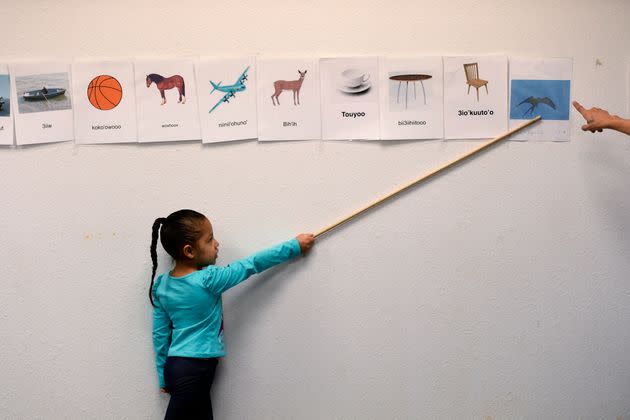Teaching Indigenous Languages In Schools Is A Powerful Form Of Decolonization

A 5-year-old names objects and animals in the Arapaho language in February 2017 as the tribe works to recover its culture and language on the Wind River Reservation in Wyoming.
WhenIwas in grade school, my history teachers always talked about Native American people in past tense, which is both telling and, well, wildly disrespectful. We were somehow taught to believe that these communities had either been wiped out or totally sequestered in small pockets of the country, without any context for what modern Native life is like.
The reality, I soon learned, is that Native American people and culture still exist all around us. But one important part of Indigenous identity — language — is fading out. So where do educators start when it comes to reversing institutionalized erasure?
By revitalizing language instruction, for one. Some schools in Washington state are partnering up with Native American communities to offer Indigenous language instruction. Among them are educators in the Bethel School District ― where around 5% of students have Indigenous heritage ― who collaborated with members of the Nisqually Tribe to offer Lushootseed language classes to students.
At Wapato High School, also in Washington, students can learn Ichishkíin, the language of the Yakama Nation, according to The Seattle Times. These districts are pioneering a program that’s set to expand all over that state — and not a moment too soon. The majority of Indigenous languages in the U.S., Canada and Australia are predicted to disappear within three generations, according to a recent analysis by researcher Gary Simons.
Offering Indigenous language instruction is particularly important in states such as Washington, where 4.1% of people identify as Native American — and the numbers are growing. Learning your native language can be a meaningful way to explore and connect with your heritage. Some studies have shown that learning a mother tongue can help foster a stronger sense of identity and belonging, which is largely believed to contribute to a longer, healthier life.
And the benefits of more Indigenous language instruction reach beyond those with Indigenous ancestry. The cultural immersion that comes with learning a new language could help non-Natives to appreciate and respect the autonomy and culture of Native American people, too, creating a more equitable future for all of us.
In recent years, the concept of “decolonizing” everything has become a buzzy, almost trite concept. But this program, at its core, is a solid example of what decolonization looks like: to directly address the erasure of a people by teaching and reinforcing language. And while it will take awhile to get a framework in place to expand this programming all over the U.S., supporting it will be crucial.
